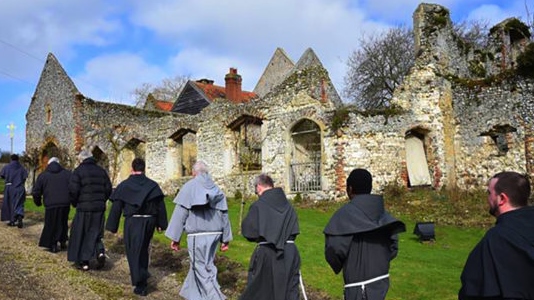 Our friars of Great Britain & Ireland, the Blessed Agnellus of Pisa Custody, are known as the “Greyfriars.” At Walsingham, England’s National Marian Shrine, on March 19, 2018 (The Feast of St. Joseph), the Minster General of our Order and the 119th Successor to St. Francis of Assisi, the Most Reverend Fr. Marco Tasca, OFM Conv., and our Assistant General, Friar Jude Winkler, OFM Conv., while on pilgrimage, took part in this EWTN Great Britain report.
Our friars of Great Britain & Ireland, the Blessed Agnellus of Pisa Custody, are known as the “Greyfriars.” At Walsingham, England’s National Marian Shrine, on March 19, 2018 (The Feast of St. Joseph), the Minster General of our Order and the 119th Successor to St. Francis of Assisi, the Most Reverend Fr. Marco Tasca, OFM Conv., and our Assistant General, Friar Jude Winkler, OFM Conv., while on pilgrimage, took part in this EWTN Great Britain report.
A bit of history:
In September of 1224, St. Francis sent the first friars to establish a Franciscan presence in England. They were drawn to the Medieval Christian Shrine devoted to Mary, the Mother of God, known as Mary’s Dowry, Walsingham. They established friaries in Canterbury, London and Oxford. After already having established a Franciscan presence in Paris, Blessed Agnellus of Pisa was chosen by St. Francis to lead the effort, along with a group of his confreres. He became the first Minister Provincial of the newly established province. Blessed Agnellus died in the 1236 and his grave and the church in which he was buried were destroyed during the persecution of the Catholics in the reign of Henry VIII.
At the time of the English Reformation (1534), there were around 60 Conventual Franciscan (OFM Conv.) friaries and six Observant (O.F.M.) friaries, in England. Henry VIII suppressed Religious and all of the the Observant friaries were closed and the King ordered a general survey of all church revenues in the realm. In the next two years, 376 religious houses had been suppressed but the Conventual Franciscans assets were of little worth to the King. The friaries were poor, property was in disrepair and that had little possessions. However, by 1538, the King had suppress the Conventual Franciscans as well. Be that as it may, all Conventual Franciscan friaries were suppressed by 1538. Conventual Franciscans returned to England in 1906 and through tough missionary work reestablished their presence in by 1910, when invited by the bishop of the Southwark diocese to Rye, East Sussex, then Liverpool (1926) and Manchester (1929).
